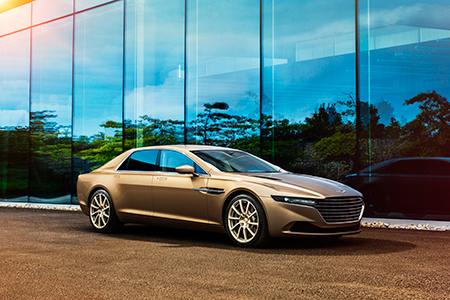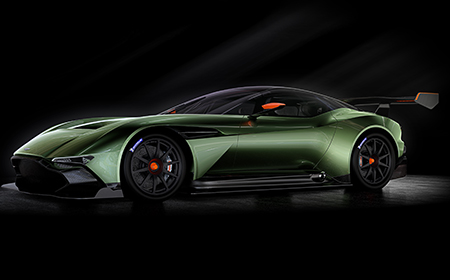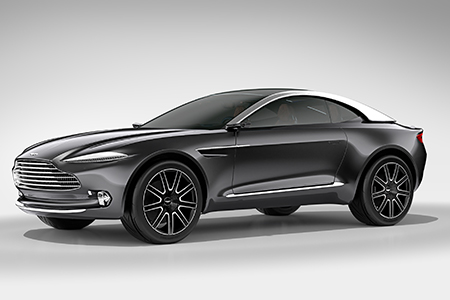Aston Martin’s Big Reveal
by Natasha Wolff | March 13, 2015 11:55 am
Since escaping from under the thumb of Ford nearly a decade ago, Aston Martin has occupied a peculiar niche in the automotive universe. Its free-agent status has allowed the manufacturer to wander a bit, sometimes bucking a trend to strike gold and sometimes, unfortunately, adapting too slowly to a changing market. There is no mistaking an Aston Martin’s sinuous styling and trademark sound, but their low production volume has created an opportunity for competing, higher-volume manufacturers to co-opt (and capitalize) on a design vocabulary largely authored by Aston Martin[1]. Without naming names, there are several cars currently on the road, especially in the performance/sports car genre, that liberally “borrow” from the esteemed British manufacturer—the gaping Whale Shark grille, the throaty exhaust note and the hunched rear quarter of Aston Martins have all found their way onto the lot of other makes in recent years.
An opportunity last month to test drive the range of current offerings from the 102-year-old manufacturer brought up a troubling question: does a revered, historic brand that has been tirelessly emulated and copied have an obligation to alter its product to stay relevant? Of course, designers will be inspired by other designers, and this cross-talk is what keeps the industry vibrant and moving forward as a whole, but what’s left of the icon when it’s been nearly picked clean? To draw an analogy from the fashion world, should Louis Vuitton have to alter its monogram print or Burberry its trademark check to distance themselves from the countless mass-produced replicas?
While I enjoyed driving the Rapide S, Vanquish, and (my personal favorite) the Vantage, I was left grasping for an indication of where Aston Martin is headed; what will be the brand’s signature in this, its second century? Despite the fact that, under the bonnet, these cars[2] are ahead of the engineering curve on several fronts, a sense that I was having difficulty putting on my finger on still left me questioning if they are relics of a bygone era.
It turns out this was a setup, and I fell for it. While this test drive sent me home to doubt my abilities to discern what’s good or remarkable about any car, let alone one that costs $120,000, (does everything have to be new all the time?), the gents at Gaydon were readying an all-out offensive on the Geneva International Motor Show.
Newly appointed CEO Andy Palmer (formerly of Nissan) addressed the brand’s current dilemma head on. “Our future needs to be based on a business that is less dependent on a narrow product portfolio and an over-dependence on one type of customer,” he said. “If we stay with business-as-usual, we are artificially restricting Aston Martin to a limited customer offer and, therefore, to a volume incapable of allowing us to fund a continually renewed, contemporary portfolio. In short, we will continue to be challenged by relatively short periods of success and periods of reduced prosperity.”
From what seemed the brink of irrelevance—a distinguished heritage that has been nearly assimilated to death—post-Geneva Aston Martin looks ready for a resurgence, set to reclaim its title as the “epitome of ‘Power, Beauty and Soul.’” While the reinvention battle cry is currently a popular movement/marketing shtick for luxury automakers, I believe this one. The next generation of Aston Martins, in the form of these limited edition and concept vehicles exhibited at Geneva, laid out a roadmap as to how they’ll get there:

The Lagonda
Lagonda
Revealed late last year, the Lagonda is a limited-edition revival of one of the strangest and most wonderful Aston Martins, whose last iteration was produced nearly 30 years ago. This “super-saloon” was originally developed with Middle East buyers in mind, but due to overwhelming interest will be available in the UK and Europe as well.

The Vantage
Vantage GT3 Special Edition
For me, the Vantage has been the gem of Aston Martin in recent years. It’s compact and minimal, engineered for performance and a blast to drive. This GT3 Special Edition is the most powerful Vantage yet (nearly 600hp from its 6.0 Litre V12 engine). It has been “comprehensively re-engineered,” featuring a lower, wider stance and is 200lbs lighter than previous Vantage models. Sadly but to no surprise, all 100 of this limited edition are already spoken for.

The Vulcan
Vulcan
Palmer says the Vulcan, the statement piece, “expresses the dark art of Aston Martin to perfection.” This sinister-looking, track-use only car (limited edition of 24) was developed in partnership with Aston Martin Racing, and is outfitted with a carbon fibre monocoque, big ‘ol Brembo brakes and six-speed sequential gearbox and produces nearly 800hp.

DBX Concept
DBX Concept
An all-electric, all-wheel drive sports crossover. Still in its early phases, the DBX brings Aston Martin’s signature style and performance (as well as a dash of their heritage of gran-tourers) to a new generation of consumers that are equally efficiency- and luxury-minded.
- Aston Martin: http://dujour.com/lifestyle/aston-martin-2013-new-car-review/
- cars: http://dujour.com/tag/cars/
Source URL: https://dujour.com/life/aston-martin-lagonda-vantage-vulcan-dbx-cars/